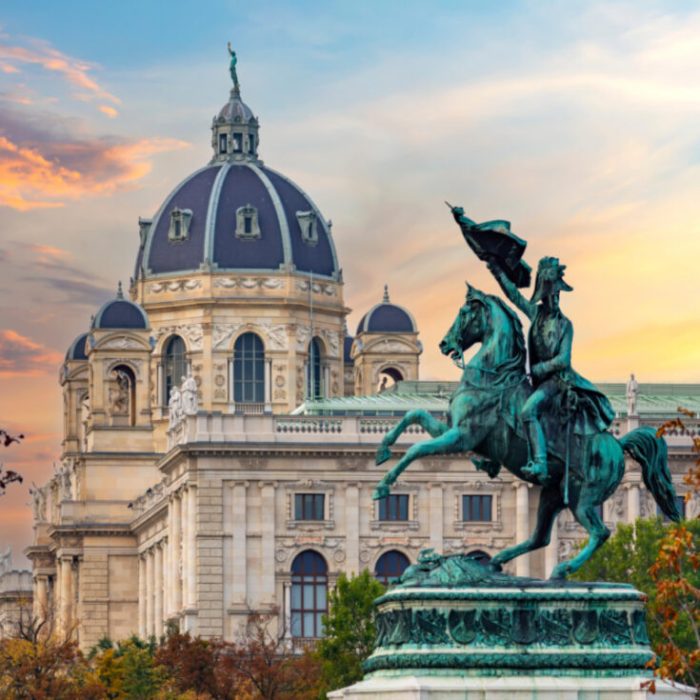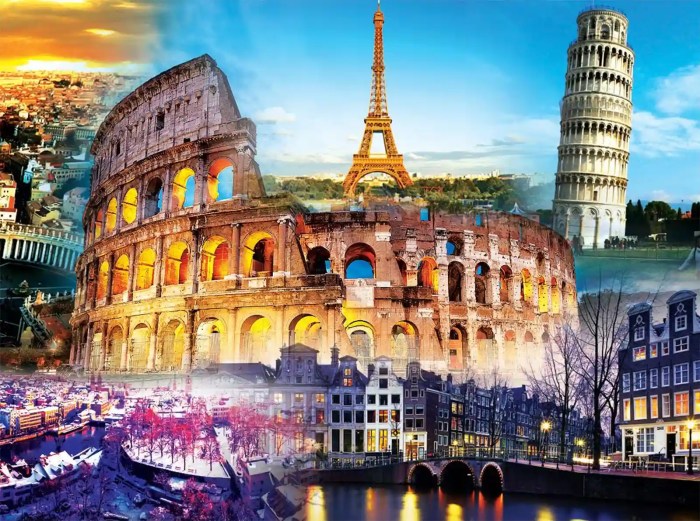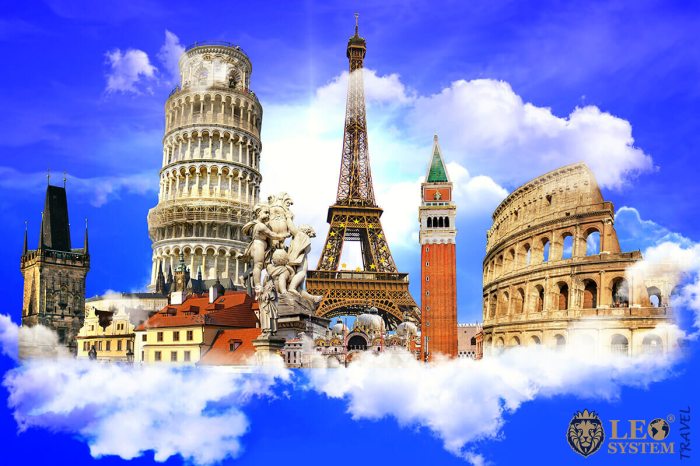Cultural tours in Europe – Embark on a captivating journey through the heart of Europe’s rich cultural tapestry with cultural tours. Immerse yourself in the vibrant customs, explore iconic landmarks, and savor the diverse artistic expressions that have shaped this extraordinary continent.
From the awe-inspiring architecture of ancient ruins to the masterpieces of Renaissance art, from the delectable flavors of regional cuisines to the vibrant rhythm of traditional music, cultural tours in Europe offer an unparalleled opportunity to connect with the soul of this remarkable region.
Cultural Immersion

Immerse yourself in the vibrant tapestry of European culture, where traditions and customs intertwine to create a rich and diverse heritage. Engage with locals, participate in traditional festivities, and delve into the nuances of European etiquette to gain a profound understanding of the region’s cultural fabric.
Local Customs and Traditions
Embracing local customs and traditions is essential for an authentic cultural experience. Attend village markets, witness religious processions, and join in on folk dances. These activities offer a glimpse into the heart and soul of European communities, allowing you to connect with their unique perspectives and values.
Respectful Cultural Etiquette
Respecting cultural norms and etiquette is paramount when interacting with locals. Familiarize yourself with local customs, such as greetings, dining etiquette, and appropriate attire. By being mindful of cultural sensitivities, you not only show respect but also foster meaningful connections with the people you meet.
Historical Landmarks

Europe is a treasure trove of historical landmarks that bear witness to its rich and diverse past. These iconic sites have shaped European identity, showcasing architectural marvels, commemorating significant historical events, and embodying cultural influences that have left an indelible mark on the continent.
From the ancient ruins of Rome to the Gothic cathedrals of France, from the Renaissance masterpieces of Italy to the industrial heritage of the United Kingdom, Europe’s historical landmarks offer a tangible connection to the past and a glimpse into the forces that have shaped its present.
The Acropolis, Athens, Greece
The Acropolis, a UNESCO World Heritage Site, is the ancient citadel of Athens and one of the most iconic landmarks in Europe. It is renowned for its stunning architectural masterpieces, including the Parthenon, the Erechtheion, and the Propylaea.
These structures exemplify the architectural genius of ancient Greece and have had a profound influence on Western architecture. The Parthenon, in particular, is considered one of the greatest architectural achievements of all time.
Planning a cultural tour in Europe can be an enriching experience, but managing your travel budget is crucial. To help you estimate expenses, consider using a travel budget calculator. This tool provides insights into potential costs, allowing you to tailor your itinerary and optimize your spending while immersing yourself in the diverse cultural offerings of Europe.
The Colosseum, Rome, Italy
The Colosseum, also known as the Flavian Amphitheatre, is an iconic symbol of ancient Rome and one of the most popular tourist destinations in Europe. This massive amphitheater was built in the 1st century AD and could accommodate up to 80,000 spectators.
It hosted gladiatorial contests, animal hunts, and other public spectacles that entertained the Roman masses. The Colosseum is a testament to the grandeur and brutality of ancient Rome.
The Eiffel Tower, Paris, France
The Eiffel Tower is a wrought-iron lattice tower on the Champ de Mars in Paris, France. It is named after the engineer Gustave Eiffel, whose company designed and built the tower.
Completed in 1889, the Eiffel Tower was originally intended as a temporary structure for the 1889 World’s Fair. However, it has become one of the most iconic landmarks in the world and a symbol of Paris.
Art and Architecture
Immerse yourself in the vibrant tapestry of European art and architecture, where masterpieces of painting, sculpture, and design have shaped the cultural landscape for centuries. From the iconic Louvre Museum in Paris to the architectural wonders of Antoni Gaudí in Barcelona, Europe is a treasure trove of artistic and architectural marvels.
The influence of European art and architecture on global culture is undeniable. Renaissance masterpieces like Leonardo da Vinci’s Mona Lisa and Michelangelo’s David continue to inspire artists worldwide, while Gothic cathedrals and Baroque palaces serve as symbols of cultural heritage and architectural prowess.
Famous Museums and Galleries
- Louvre Museum, Paris: Home to the Mona Lisa and Venus de Milo
- Uffizi Gallery, Florence: Showcases works by Botticelli, Michelangelo, and Leonardo da Vinci
- Rijksmuseum, Amsterdam: Features Dutch Golden Age paintings, including Rembrandt’s The Night Watch
- Tate Modern, London: A contemporary art museum housed in a former power station
Architectural Masterpieces
- Colosseum, Rome: An iconic amphitheater that hosted gladiatorial contests
- Notre Dame Cathedral, Paris: A Gothic masterpiece with intricate stained glass windows
- Sagrada Familia, Barcelona: An unfinished masterpiece by Antoni Gaudí, renowned for its unique architecture
- Eiffel Tower, Paris: A symbol of the city, offering panoramic views from its summit
Cuisine and Gastronomy: Cultural Tours In Europe

Europe is a culinary paradise, offering a diverse range of cuisines and regional specialties. From the hearty stews of Eastern Europe to the delicate pastries of France, European cuisine is a testament to the continent’s rich cultural heritage.
Traditional dishes often reflect the local environment and ingredients. In coastal regions, seafood is a staple, while inland areas rely on meats, vegetables, and dairy products. Cooking techniques vary from country to country, but common methods include grilling, roasting, and stewing.
Cultural tours in Europe offer a deep dive into the continent’s rich history and heritage. From ancient ruins to medieval castles, these tours showcase the architectural marvels and cultural landmarks that have shaped Europe. Many of these iconic sites are recognized by UNESCO as World Heritage Sites, a testament to their exceptional universal value.
Exploring these UNESCO World Heritage Sites not only provides a glimpse into the past but also enriches the overall cultural tour experience, offering a deeper understanding of Europe’s diverse cultural tapestry.
Regional Specialties
Some of the most famous regional specialties include:
- Paella (Spain): A rice dish with seafood, vegetables, and meat.
- Goulash (Hungary): A beef stew flavored with paprika.
- Pizza (Italy): A flatbread topped with tomatoes, cheese, and various toppings.
- Sauerkraut (Germany): Fermented cabbage often served with sausages.
- Crêpes (France): Thin pancakes that can be filled with sweet or savory ingredients.
Cultural Significance, Cultural tours in Europe
Food and dining experiences hold great cultural significance in Europe. Meals are often shared with family and friends, and they provide an opportunity for social interaction and bonding. In many cultures, certain dishes are associated with specific holidays or festivals.
European cuisine has also influenced culinary traditions around the world. Many dishes that are now considered international classics, such as pasta and pizza, originated in Europe.
Performing Arts

Europe is a vibrant hub for performing arts, boasting a rich history and cultural heritage that continues to captivate audiences worldwide. From the grandeur of opera houses to the intimacy of theaters, Europe offers an unparalleled array of venues and performances.
Music plays a central role in European culture, with renowned concert halls hosting classical orchestras, chamber ensembles, and soloists. Opera, with its fusion of music, drama, and spectacle, has flourished in Europe for centuries, with iconic opera houses like La Scala in Milan and the Royal Opera House in London showcasing world-class productions.
Dance
Europe has a long and distinguished tradition in dance, with ballet companies and contemporary dance troupes pushing the boundaries of artistic expression. The Bolshoi Ballet in Moscow and the Paris Opera Ballet are among the most celebrated ballet companies globally, while cutting-edge contemporary dance is showcased at venues like Sadler’s Wells in London and the Palais de la Danse in Paris.
Theater
European theater has a rich history, dating back to the ancient Greeks. Today, theaters throughout Europe present a diverse range of productions, from classic plays to contemporary dramas. The Globe Theatre in London, a reconstruction of Shakespeare’s original playhouse, offers an immersive experience of Elizabethan theater, while modern theaters like the National Theatre in London and the Comédie-Française in Paris showcase innovative and thought-provoking works.
The performing arts in Europe are not only a source of entertainment but also a vital part of cultural identity and global influence. European opera, music, dance, and theater have shaped the artistic landscape worldwide, inspiring countless artists and audiences across generations.
Cultural Festivals and Events

Europe is a continent with a rich and diverse cultural heritage, and this is reflected in the many cultural festivals and events that take place throughout the year. These festivals offer a unique opportunity to experience the culture of a particular region or country, and to learn about its history, traditions, and people.
Some of the most popular cultural festivals in Europe include the Edinburgh Fringe Festival, the Oktoberfest in Munich, and the Carnival in Venice. These festivals attract millions of visitors each year, and they offer a wide range of activities, from music and dance performances to food and drink stalls, and parades.
For those seeking an immersive cultural experience in Europe, consider incorporating eco-lodges into your itinerary. These eco-friendly accommodations, like the ones featured on eco-lodges , offer a unique blend of comfort and sustainability. Nestled amidst picturesque landscapes, they provide an opportunity to connect with nature while exploring Europe’s rich cultural heritage.
Whether you’re traversing the rolling hills of Tuscany or navigating the canals of Venice, eco-lodges enhance your cultural immersion, leaving a lasting impression.
Major Cultural Festivals and Events in Europe
| Festival/Event | Dates | Location | Description |
|---|---|---|---|
| Edinburgh Fringe Festival | August | Edinburgh, Scotland | The world’s largest arts festival, featuring over 3,000 shows in venues across the city. |
| Oktoberfest | September-October | Munich, Germany | The world’s largest beer festival, attracting over 6 million visitors each year. |
| Carnival in Venice | February-March | Venice, Italy | A masked ball and street party that takes place over two weeks. |
| La Tomatina | August | Buñol, Spain | A tomato-throwing festival that attracts over 20,000 participants each year. |
| Glastonbury Festival | June | Somerset, England | One of the world’s largest music festivals, featuring over 2,000 acts on multiple stages. |
Cultural festivals and events play an important role in European society. They provide a way for people to come together and celebrate their shared culture, and they also help to promote tourism and economic development. In addition, these festivals can help to raise awareness of important social and political issues.
Cultural Heritage Preservation

Preserving Europe’s cultural heritage is crucial for understanding our past, present, and future. It helps foster a sense of identity, cultural diversity, and sustainable development.
Numerous organizations and initiatives are dedicated to protecting cultural landmarks and traditions. UNESCO World Heritage Sites, for instance, recognize and protect sites of outstanding universal value.
Challenges and Opportunities
Preserving cultural heritage in the modern era presents both challenges and opportunities.
- Globalization and tourism: While these factors can promote awareness, they can also lead to the commodification and erosion of cultural traditions.
- Climate change and natural disasters: These can damage or destroy cultural landmarks and artifacts.
- Technological advancements: Virtual reality and 3D scanning offer new ways to preserve and share cultural heritage.
Ending Remarks

As you conclude your cultural tour of Europe, you will carry with you not only cherished memories but also a profound appreciation for the enduring legacy of human creativity and cultural exchange. The experiences you have gathered will serve as a constant source of inspiration, reminding you of the boundless beauty and diversity that Europe has to offer.
Answers to Common Questions
What are the benefits of taking a cultural tour in Europe?
Cultural tours offer an immersive experience that allows you to connect with the local customs, traditions, and history of Europe. They provide a deeper understanding of the region’s cultural heritage and its impact on the world.
What types of cultural tours are available in Europe?
There is a wide range of cultural tours available in Europe, including historical tours, art and architecture tours, culinary tours, and performing arts tours. You can choose a tour that aligns with your specific interests and preferences.
How long should I plan for a cultural tour in Europe?
The duration of your cultural tour will depend on the specific itinerary you choose. However, most tours range from a few days to several weeks, allowing you to explore multiple destinations and delve into the local culture.